| Grade : 7 | Date: 19.01.2016 | 3rd lesson | |||
| Theme |
Plants and animals of Kazakhstan |
||||
| Aim | To learn theme about animals and plants of Kazakhstan | ||||
| Expected results
|
They study text, learn create the tasks , explain the meaning some words | ||||
| Doing tasks | Complete the sentences, make True or False, translate into English or Kazakh, match the words with numbers, explain the meaning of some words | ||||
| Necessary things : textbook , resources,video, slides | |||||
| Stages | Functions of the teacher | Functions of the pupils | |||
| Warming up
5min |
Greeting . -Good morning !How are you today? Who is on duty today? Who is absent ? dividing into groups with words : wolf, fox, a bear, monkey, cockerel, goose, bird, a parrot ,a flower ,a tree, an apple-tree.
Who likes animals choose the words of animals , you are group of animals, like this others .What groups are there? Name them. |
They greet the teacher.
Pupils divide into groups with the words of animals. |
|||
| presentation
min
|
Grammar : now, let’s revise the grammar past perfect.
Last week burglars broke into the house .When the host came, he couldn’t believe his eyes. Take two pictures – They had taken two pictures A) Break/ the expensive vase- B) Eat/ all the food in the fridge- C) Steal/ some books- D) Poison/ the dog- E) Take / all valuable things- We’ve revised the grammar .
Match the definitions of the words : 1mammals are.. a)..lay eggs.many of them can 2. reptiles… fly.Their blood is warm. 3birds are… b)..have got cold blood .They all lay eggs. Their skin is thick. c) ..give milk to their babies.
All of you watch this video: Tell us what about is it? Questions: Do you like animals? What domestic animals do you know? What animals are in Kazakhstan? What plants do you know ? Yes, Today we are going to learn about “Animals and plants in Kazakhstan” . Firstly, let’s study the new words . Vocabulary: 1.Open space [ ˈəʊ pən speɪs ] -ашық орын, кеңістік 2Amphibians [ æmˈfɪb.i.ən ] — қос мекенділер 3Reptiles [ ˈrep.taɪl бауырымен жорғалаушылар 4Rare [ reə(r) ] сирек 5.Transcaspian urial- Транскаспий арқары 6.Long-needle hedgehog- ˈhedʒ.hɒɡ ]ұзын инелі кірпі 7.Ibex-[ˈaɪbeks] тау ешкі 8.Scope- [ skəʊp ]масштаб,көлемі 9.Vulture- ˈvʌlʧə күшіген 11.Finches [ fɪntʃ ] – таушымшық 12.Chough [ ʧʌf ]галка 13.Central Asian Turtle –Орталық Азия тасбақасы 14.Gecko [ ˈɡek.əʊ ]-геккон 15.A giant moose [ ˈdʒaɪənt muːs ]алып бұғы 16.Sable [ ˈseɪbl̩ ] бұлғын 17.chipmunk [ ˈtʃɪp.mʌŋk ] бурундук 18bush- [ bʊʃ] бұта 19meadow [ ˈmed.əʊ ]шабындық,шалғын 20elm[ elm]- вяз, қарағаш 21poplar- [ˈpɔplə] терек 22cedar- [ˈsiːdə] кедр 23larch [ lɑːtʃ ] бал қарағайы 24spruce [ spruːs ]шырша 25scrub [ skrʌb ]бұта 26hawk- hɔːkсұңқар 27waterfowl wɔː.tə.faʊl суда жүзетін 28falcon ˈfɔːlkən сұңқар Coniferous trees- қылқан жапырақты ағаштар Over six thousand kinds of plants are growing in Kazakhstan (from them 515 — only here), on its open spaces it is possible to meet about 500 kinds of birds, 178 kinds of animals, 49 kinds of reptiles, 12 kinds of amphibians, and in the rivers and lakes — 107 kinds of fishes. Animals Only in Kazakhstan live such rare animals as Transcaspian urial, long-needle hedgehog and some wild cats: caracal and desert cat. Tien Shan brown bear, Siberian ibex, and from birds — famous lammergeyer, the scope of which wings reaches more than three meters, Snow cock (it calls also mountain turkey), snow vulture, griffon vulture, favorite of the Kazakh hunters — golden eagle, high-mountainous finches, chough and Alpine chough. — Central Asian turtle, the largest lizard — grey monitor lizard (lives only in Kyzylkum desert), sand- and toad agama, many kinds of gecko and 17 kinds of the snakes. In the Altai mountains of Kazakhstan you will meet a giant moose, beautiful maral, our smallest deer — musk deer, famous sable, chipmunk. Plants The slopes of Northern Tien Shan are covered with fur-tree woods, and Western Tien Shan — with the low bushes and meadows; the gorges have apple- and nut-trees with woods, Thickets of elm, poplar, reeds, and shrubs grow along the banks of rivers and lakes. Coniferous trees, such as spruce, larch, cedar, and juniper in the forests. Drought-resistant plants such as wormwood, tamarisk (salt cedar), and feather grass are native to the steppes, although grain crops have largely supplanted native vegetation in the northern steppes. Scrub plants are common in the Qyzylqum desert. Birds . On lakes there are a lot of waterfowl birds. And in the woods on its coast were kept nesting-places of such rare birds as fish hawk and black stork; at tops are living very rare here snow cock. A lot of predatory birds are living in Kazakhstan steppes — imperial eagle, falcons. Here is possible to see capercaillie, hazel grouse, partridges deserted birds — black-tailed sand grouse, Pallas sand grouse, wheatear and larks.
|
Read the text .
Work in chorus, repeating the words ,
Do grammar tasks |
|||
| Main part
|
Group work:
1.create the task “true or false” 2.Match the numbers 3. Complete the sentences |
They work in groups | |||
| conclusion
|
1.Explain the words :”.
2.make the thick ,thin questions: Make the questions using the beginning of these questions: 1. give me 3 explanations why…? 2.why do you think…? 3.why do consider …? 4.What’s difference…? 5.suppose what will be, if …? 1 Who..? 2. What …? 3. When …? 4 May be/Might be …? Do you agree with? Is it right ,if…? Reflection: 1. Knew: I ‘ve known the words about animals and plants 2. Learnt : about the animals in Kazakhstan 3.Used: some facts about animals ,plants H/w: writing “ to bring information one of the animals or plants in Kazakhstan’’ |
Make, ask the questions
Рефлексия : 1. білдім: 2. есіме сақтадым : 3. қолдандым: |
|||
| Analyzing of herself | |||||
| Changes for the lesson
|
|
||||
Ілмекresources slides textbook video
 sabaq.kz sabaq.kz
sabaq.kz sabaq.kz

